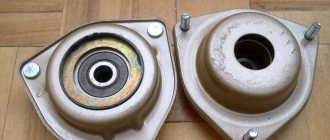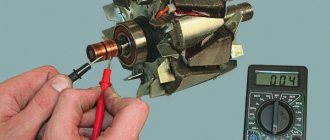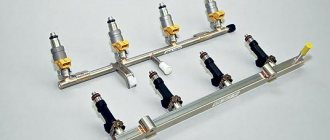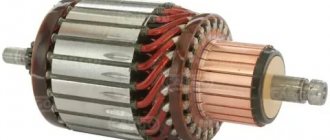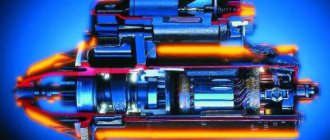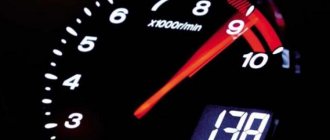When malfunctions occur in the front suspension of a car, one of the first measures that its owner should take is check the support bearing, located between the support and the upper spring cup. To do this, you will need to grab the “cup” of the rack with your hand (put your hand on the support) and rock the car. Constant, sharply changing loads, including shock loads in combination with abrasive dust particles, contribute to the wear of the components of the support strut bearing and ultimately completely disable it. As a result, it begins to play, knock, squeak or squeak, and the shock absorber rod deviates from its axis.
Diagram of the support bearing operation
Such problems with its operation can lead to more serious consequences in the car’s suspension. Since wear of the support bearing will lead to a violation of the wheel alignment angles, and consequently, a deterioration in the car’s handling and accelerated tire wear. How to check and which manufacturer of thrust bearings to give preference to when replacing - we will tell you about all this in more detail.
A little about the design of the car suspension
Let's talk about the suspension design
— almost all mass-produced cars now use the so-called MacPherson suspension, named after its inventor. An important element of the suspension are shock absorber struts.
MacPherson strut is also called the “swinging candle”
due to its design features. The device contains a spring, a damper and a shock absorber on one axis, which absorbs the energy of vertical vibrations of the car, ensuring a smooth ride.
The upper part of the rack is attached to the body
car using a special rubber bushing - the upper support. These undercarriage components transfer variable vertical load from the wheels to the body during operation.
In the front supports
In addition, a rolling element is required, a strut bearing, which allows the strut to rotate. By design, the support in the front of the car differs from the rear in that a strut bearing is installed there.
What are the functions of shock absorbers and upper mounts?
All tasks assigned to the main parts of a car’s suspension can be divided into two categories: those responsible for the safety of the driver and passengers and those providing comfort while driving.
So, when talking about safety, we first of all mean reliable contact of the wheels with the road: minimizing vertical swaying, “jumping” on holes and potholes, and dangerous deviations of the trajectory when turning. Thus, shock absorbers and upper supports create reliable grip on the road surface and allow the wheel to go around the obstacle as efficiently as possible, and then quickly and quietly return to its original position.
At the same time, they help to increase comfort while driving: it is thanks to their “softening” effect that we do not feel all the unevenness of the road, and are also spared the constant shaking and annoying rattling of car parts.
Support bearing
Strut support bearing (OP)
installed inside, between the front shock absorber rod mounting unit and the upper spring cup. As a rule, the design is an angular contact rolling bearing, but there are also sliding pairs made of metal bushings.
The strut support where the rear shock absorber rod rests
- consists of rubber bushings and a metal spacer, but can also be a solid rubber-metal part of the cup.
This “dual role” of the front support – rotation and thrust – and high loads lead to a certain amount of natural wear. After some (quite long) time, the upper support will need to be replaced.
Signs of wear on shock absorbers and upper mounts: identify and eliminate!
| published 03/11/2016 |
Any motorist will confirm: our roads are impossible without good shock absorbers! And it’s not even about the quality of the first ones - or rather, not only about it. Alas, Russian climatic conditions with nine months of winter are by no means conducive to a comfortable and trouble-free ride: sometimes ocean-deep puddles, sometimes shoulder-deep snowdrifts, sometimes a mess of salt, sand and reagents, sometimes bare ice. So shock absorbers and upper supports have to take the lion's share of responsibility - which means premature wear is inevitable. Read this article on how to promptly diagnose faulty shock-absorbing elements and avoid expenses associated with subsequent repairs.
Signs of a faulty support bearing
“A good knock will make itself known”
- say drivers and auto mechanics. This is just about the support bearing - it lets you know about its malfunction with a characteristic metallic knock that occurs in the area of the front wheels. The knocking noise may intensify when driving on uneven roads, when turning, sharp accelerations, when the car is heavily loaded and at high speed.
Another signal
, which tells us about the wear of the strut bearing - knocking and crunching when the steering wheel is rotated while driving. An experienced driver will notice a change in the behavior of the car on the road, the appearance of a delay in the reaction to the rotation of the steering wheel, and a violation of the car’s stability on the course. The steering wheel may jam.
The mileage of the car can also be considered “signs” of failure.
Most bearing manufacturers estimate the product resource to be approximately 100 thousand km, quite high figures. But on our roads this value can be safely divided in two. So after 50 thousand km you can already expect a bearing failure. Although no one is immune from the fact that this will happen in 10 thousand.
Of course, knocking and crunching can also be caused by malfunction of other suspension elements. Therefore, it is advisable to carry out a full check of the chassis. But first you still need to check the support bearing.
In addition to wear, other problems are possible.
front support unit. Dull knocks when driving on uneven sections of the road may be a sign of wear on the rubber casing, or separation of the rubber from the metal. It can even be pierced through by the shock absorber.
It looks like there are signs of wear on the rear support:
squeaks and knocks (“suspension breakdowns”) in the rear suspension area. Moreover, there are no sounds when the car passes a round obstacle, and there are sounds when the rear wheel falls into a hole. A bumpy car can be caused by increased play in the parts of the support assembly.
Malfunction of other rack elements
All of the above methods for checking the rolling element are quite accurate and effective. But none of them gives a 100% guarantee until the unit is disassembled. The cause of the creaking that appears in the area may be steering rods or other adjacent parts or suspension elements.
Spring fault
If the strut spring sags or breaks, this will immediately result in a deterioration in comfort and a decrease in the vehicle’s handling quality. And hence the decline in road safety in general. A sagging spring on one of the wheels is clearly visible visually. Creaking and grinding noises are only possible if it breaks.
How to identify a malfunction of the support itself (not the bearing)
If the support is worn out, a dull sound or knocking sound will be heard when overcoming uneven sections of the road. It is easy to verify that the support is faulty; you just need to assess the condition of the rubber bands. If they are damaged or do not take their place, the entire support will have to be replaced.
Compression progress buffer failure
A rubber or polyurethane compression stroke buffer may lose its integrity or elasticity over time. In this case, extraneous creaks and noises may appear that occur at the moment of maximum compression of the spring. A standard visual inspection of the element will help verify the malfunction (or absence thereof).
Shock absorber wear
There are several ways to determine the wear of a part. This includes noise on bumps and excessive body roll, especially during sharp turns. The malfunction of the shock absorber is most clearly felt when overcoming an uneven section at speed, when the car continues to sway for some time.
Causes of malfunction of the rear and front supports
- Normal Wear
- When operating your machine, be prepared to experience more wear and tear on the bearings than the manufacturer claims. - Getting sand and dirt inside
- The fact is that the journal bearing is a type of rolling bearing, and it is not structurally designed to provide protection from the mentioned harmful factors. - Harsh driving style
- Driving on bad roads at high speed leads to excessive wear not only on the support bearing, but also on other elements of the car’s suspension. - Low quality of the part
- This is especially true for domestically produced bearings, in particular for VAZ cars.
The main cause of breakdowns
– a large load on the supports and the resulting wear. As already mentioned, driving on broken roads doubles your output. It is also accelerated by the ingress of water, dirt and dust into it. Water and dirt have a particularly negative effect on the condition of the OP, leading to wear of the components of the strut bearing.
You can fight this
washing and generously lubricating the bearing, at any opportunity. Thanks to this, the support bearing will be better protected from dirt. There is no such thing as too much lube!
A possible cause of failure is
and low quality parts, especially those made in China.
Chinese bearings have performed poorly.
“I bought Chinese bearings, they didn’t last long, so from now on I will only buy originals” - this is a typical review from the Internet.
Suspension breakdowns are dangerous for the rear support unit,
when the wheels fall into a hole, the vehicle moves with an overload.
The front support assembly does not like aggressive driving.
What is typical for the front support is that the failure of one part leads to accelerated wear and premature failure of other parts of the assembly.
Replacement
Replacing the front support bearings is quite simple. The main thing is to find a really high-quality part, because not all manufacturers can provide supports with a high degree of wear resistance. So, we arm ourselves with the following tools:
- spanner;
- head for disassembling racks;
- spark plug head for ratchet;
- rod nut wrench;
- spring compressors.
And, of course, the prop himself. We will carry out the replacement procedure as follows:
- Jack up and remove the wheel.
- Remove the two nuts securing the front strut to the hub.
- Unscrew the nut from the shock absorber rod, while holding it with a hexagon.
- We remove the stand.
- Compress the spring and remove the support bearing.
- We again clamp the hexagon on the rod and unscrew the nut.
- We remove the bearing, install a new one and repeat all the steps, only in reverse order.
The cause of knocking while turning may be a malfunction of the steering rack, steering shaft or steering cardan. Therefore, after replacing the support, the problem may not disappear. In this case, all of the above systems should be checked.
Video on replacing the support:
Roads are called one of the two main “troubles” of Russia. Constant holes and potholes cause not only inconvenience in terms of comfortable movement, but also cause significant damage to the car’s suspension, its individual elements, especially bearings. Replacing them is not difficult, even a beginner can handle it, but diagnosing the need for this replacement in a timely manner is much more difficult, especially without knowing the signs of a faulty support bearing. We will talk about them further, but first a little theory.
Methods for checking the rear support assembly
We recommend reading 2 ways to diagnose the rear strut support assembly. It's good if someone helps you.
The first method (on the go), as for checking the front support bearings
- find your way on a road with bumps and obstacles;
- ride on uneven surfaces, changing the speed;
- accelerate, brake, turn on obstacles - load the rear supports.
Bumps and crunching sounds from the rear indicate that it is time to change the rear support.
A bad sign is malfunctions in the rear shock absorbers, “breakdowns” during these impacts.
The second method (on the site), as for checking the front supports
- it is necessary to install the car horizontally;
- put the vehicle on the handbrake;
- secure the wheels with wooden wedges;
- find the rear strut supports in the luggage compartment;
- remove the lining and protection, if necessary. Get to the rear shock absorber rod mounting nut;
- press the nut (upper element of the strut support) with your fingers;
- ask your friend to rock the back of the car. A knocking and crunching sound, the same as you heard when moving, or if the rod moves relative to the support (you can feel this with your hand), the condition of the system is unsatisfactory. The situation can only be corrected by installing a new one.
Replacement of front suspension strut support for Lada Granta
Domestic car owners quite often have to take measures to repair the chassis of the Lada Grant. The reasons that prompt repair procedures are the same well-known knocking, creaking and other upsetting factors. “As soon as I grabbed the levers, the racks made themselves felt”! This is not surprising, since most domestic roads leave much to be desired in terms of quality.
The chassis of the Lada Grant is sensitive to potholes and other irregularities, which gradually affects its condition in a far from good way. Blaming the roads is a valid idea, but not entirely fair. Here we need to remember the valiant designers of VAZ, who are aware of the state of the roads, but also continue to develop suspensions without taking into account the possibility of sufficiently strengthening the structure. After all, this could not only have a positive effect on the overall resource of the car, but also sway a larger number of fans, and especially Lada Grant owners, towards the products of the domestic automotive industry.
Today we will talk about techniques for changing the support bearing in the popular and practical VAZ model Lada Granta.
What adds interest to the process is the fact that this is not a simple replacement of the support bearing, but a technology without dismantling the rack.
Only the front strut support bearing that has actually become unusable should be replaced. Read about methods for checking the condition of these rack elements here.
Those owners who have at least once been faced with the need to replace the support bearings of a LADA Granta will, with a significant sense of confidence and a squeal of exclamation, prove the need to remove the strut during this procedure. The very dismantling of struts with springs, of course, adds difficulties associated with the need for special devices, and takes up a much larger time resource. But laziness forces a person to bypass difficulties and develop progress in order to ease his lot.
The illustrations in the photo report show in detail the process of changing the support bearing of the front strut without dismantling the struts in a LADA Granta.
To work you will need to stock up:
- a key set with the following sizes: “13”, “14”, as well as “17” and “22”;
- a hexagon that allows you to keep the rod itself from turning;
- two jacks and supports;
- with special ties of coils of spring liners.
How to extend service life
Even if you do not notice any problems with the suspension while driving, it is recommended to carry out regular (every 20 thousand km) checks of these components. Once a year, the rubber part of the support assembly is coated with silicone grease. Driving carefully and avoiding bad roads will also help protect your suspension components.
To increase the service life of the OP, if possible, technicians rinse it and replace the lubricant. If this part begins to deteriorate, it will need to be replaced; repair of the support bearing is impossible.
How to check the knock of the prop on VAZ cars
Before replacing a part, make sure that it has actually failed. On VAZ cars, the condition of the racks and supports should be checked 1-2 times a year. This is what auto mechanics advise in service centers. You can use a fairly simple method, but it will require 2 people. The degree of wear of the support bearing can be determined quite accurately by following these steps.
To clearly demonstrate the verification process, watch the video:
Checking the “supporters” on VAZs
Creaking noise when turning the steering wheel
Checking and operation for a specific car model
You can find specific inspection and operating instructions for a specific car model on our website. Further in the navigation table, you can find and go to instructions for diagnosing and replacing support bearings for your car.
Navigation by instructions:
- Chevrolet:
- Lanos
- Lacetti
- Cruze
- Aveo
- Focus 2
- Accent
- Lancer 9
- Logan
- A80 B4/B3
- Astra H
- Almera
- Nexia
- Octavia
- Corolla
- Ceed
At what interval should a support bearing be diagnosed?
Various manufacturers set their own limits on the service life of this part, which experiences fairly high loads during vehicle operation. The average limit is limited to a mileage of 100,000 km. Taking into account the condition of the roadway, this could be 50,000 km or less. Typically, replacement of a part is required once every 2-3 years.
But in practice, it is necessary to change as a squeak appears, when the maximum degree of wear is reached. Well, the check should be carried out annually, after 20,000 km - mandatory. Moreover, it is not difficult to do this.
Why you shouldn’t delay repairs
When the OP has completely crumbled, you can continue moving. But driving with a damaged bearing dramatically accelerates the wear of other suspension parts. In addition, usually with this breakdown the geometry is disrupted - alignment and camber. This not only causes accelerated tire wear, but can significantly reduce the car's handling. This increases the risk of an accident. Therefore, it is not recommended to drive for a long time with damaged bearings.
Every car owner needs to know this.
The supports themselves do not require maintenance and last a long time. But it is necessary to change the worn-out part on time. A serviceable car is the key to safety on the road!
The main signs of wear on shock absorbers and upper supports
Wear or failure of shock absorbers and supports is a definitely unpleasant and dangerous situation. However, there is a plus: you can almost always diagnose the problem yourself and fix it in a timely manner, avoiding more serious consequences.
So, pay attention to the condition of the elements if you notice:
- body swaying and poor vehicle controllability;
- skidding and low cornering stability;
- obvious “sagging” during acceleration and braking;
- increased sensitivity of holes and potholes;
- unusual shaking and vibration;
- Excessive tire wear.
If during diagnostics you find wear on at least one shock absorber, feel free to change the second one too - they work in pairs. We also recommend purchasing upper mounts along with the struts to increase reliability, extend the life of shock absorbers and improve comfort and safety.
What are the best rack supports for Granta?
The main requirements for Granta and Kalina 2 support bearings are endurance and reliability. The support bearing takes the entire load from the car body, as well as from the shock absorber strut, allowing the latter to rotate freely around the longitudinal axis.
Grants support bearing diagram
The dynamic loads of the shock absorber rod are absorbed by a rubber damper. The more reliable it is, the longer the support will last. The spring rests against a support cup with a rubber-coated ball support bearing. However, different manufacturers offer different solutions for support.
Thus, some supports are produced with reinforced bearings (balls of larger diameter), there are supports with a changed caster angle. To do this, the axis of the shock absorber strut is shifted by 6 or 12 mm, which ensures a change in the caster angle to 1°40′ or 2°45′, respectively.
In addition, supports are produced both for Lada Granta and Kalina 2 with electric power steering (article 21900-2902821-10), and for cars without electric power steering (article 21900-2902821-00).
Pillow bearing without support
Standard supports cost about $12 apiece, owner reviews about them are not the most encouraging, so most often you have to buy replacements for the original:
- Pillow bearing SS20 series Master, Gold, Drive , differ in caster angle and damper design. They last quite a long time and are easy to install. The price is about 26 dollars per piece.
- ANVIS 2190 Rack Mounts , $27/pair, 6mm offset. Available for both Granta and Kalina 2 with and without EUR. Compatible with all types of springs (11190 or 11196), as well as the most popular KAYABA or SACHS struts.
- support bearings , price from $20 per pair. A budget option with the strut tilted by 1 degree and the shock absorber axis shifted back by 6 mm.
- Demfi , article number dff21901 (2190-2902822-12), are sold without a support bearing, which has catalog number 1118-2902840 . The price is about 15 dollars. Reviews are contradictory.
- Technologies of the future , article number 2192-2902821 , price about 26 dollars per pair. There are few reviews, mostly positive.
- Budget Slovak supports LSA , sold without bearings, price about $10 per pair.
- supports (SA 0156) , complete with bearing, price 10 dollars apiece, run well, good assembly, bearing of standard sizes.

